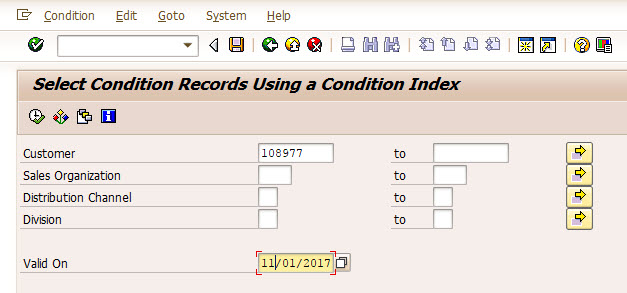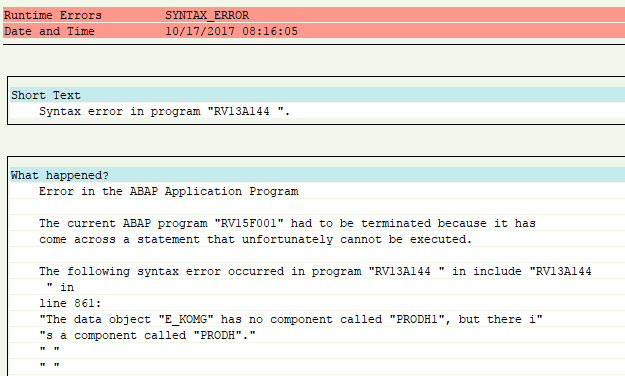
Enterprise Resource Planning Blogs by Members
Gain new perspectives and knowledge about enterprise resource planning in blog posts from community members. Share your own comments and ERP insights today!
Turn on suggestions
Auto-suggest helps you quickly narrow down your search results by suggesting possible matches as you type.
Showing results for
pkwurst
Explorer
Options
- Subscribe to RSS Feed
- Mark as New
- Mark as Read
- Bookmark
- Subscribe
- Printer Friendly Page
- Report Inappropriate Content
11-01-2017
1:51 PM
Why Index
One of the uses of the Condition Index tables is to maintain and display condition records for multiple condition types or multiple access sequences at the same time. This allows for functionality in VK12 and VK13 that is similar to using the new VK32 and VK33 transactions with a pricing report.
Condition Maintenance - VK12
Having active condition indexes allows for the use of the Select Using Index button that is available in VK12 and VK13, and shown, surrounded by the red box, below.

When clicked, the Select Using Index button will display each active index table that is configured in SAP, similar to how SAP displays the various condition tables available in the access sequence assigned to a Condition Type when clicking the Key Combination box.

Pricing indexes are not condition type, or condition table, specific. This allows for the maintenance of multiple condition types across multiple condition tables, all at the same time. This can be particularly useful when updating all prices for a given customer or material.
Example
A customer / material discount is created for 10% using condition type ZZ01.

A customer specific discount is offered to the same customer, but for only 5%, using condition type ZZ02.

Using normal condition record maintenance these two records will always need to be maintained separately, as they are two different condition types, even if they were the same they are in two different condition tables.
Using standard condition index 2, which is not activated by default, it is possible to maintain both of these conditions at the same time.

On the selection screen there are no required fields, meaning that condition records for even multiple customers could be selected, or across multiple sales areas.

Amounts for the two Condition Types can now be maintained.

Configuring
IMG Path
SPRO --> Sales and Distribution --> Basic Functions --> Pricing --> Maintain Condition Index
Change condition types

Only Condition Types that have the Condition index flag checked are added to Condition Index tables.
Maintain condition tables for index
Condition tables for indexes are maintained the same way that condition tables for standard pricing are maintained. Custom tables should start at 500. The generated tables are prefixed with KOTF, so in the example above the table KOTF002 could be viewed using SE16n.
Conditions: Allowed fields
A field catalog can be maintained, using the same methods as the standard field catalog for Pricing Condition tables. All fields from KOMK / KOMP pricing communication structures are available and can be enhanced by adding append structures to KOMKAZ and KOMPAZ.
Activation of Condition Index
In addition to activating the condition index, choosing the correct requirement is critical.

In the example above condition type ZZ01 would not have been visible in condition index 2 if requirement 001 was selected instead of requirement 002.

SAP Help Information
Challenges
Set up condition indices - V/I2
In order to populate the condition index table with condition records that were previously created it is necessary to Set up the condition indices, which is the 4th activity in Maintain Condition Index and can also be launched using Transaction V/I2 or program RV15F001. The first step that SAP performs when executing this process is to regenerate each pricing condition table, if any pricing condition table fails then the whole process fails with a Short Dump that can be viewed in transaction ST22.
Regenerate Pricing Condition Tables
SAP uses program RV12A001 to regenerate each pricing condition table. You can mimic this execution by running program RV12A001. Set the Usage to "A" and leave the table criteria un-populated, the Dictionary, Reports and screens, and Online fields should all be checked.
An issue I have run into has to do with the Pricing communication structure KOMG. If a pricing condition table exists in SAP, and for some reason the fields in the table are no longer in structure KOMG then a short dump would have been generated during the Set up condition indices step. The short dump references Program RV15F001 and program RV13AXXX, where AXXX is the condition table that SAP is having trouble regenerating.

In the example above SAP had trouble regenerating condition table A144 and it was due to the custom component PRODH1 being missing from KOMG. PRODH1 was a material specific attribute that should have been included in a customer specific append structure to the Pricing Communication Item structure KOMPAZ.
Once the problems running RV12A001 have been resolved it should be possible to successfully run the Set up of condition indicies.
- SAP Managed Tags:
- SD (Sales and Distribution)
5 Comments
You must be a registered user to add a comment. If you've already registered, sign in. Otherwise, register and sign in.
Labels in this area
-
"mm02"
1 -
A_PurchaseOrderItem additional fields
1 -
ABAP
1 -
ABAP Extensibility
1 -
ACCOSTRATE
1 -
ACDOCP
1 -
Adding your country in SPRO - Project Administration
1 -
Advance Return Management
1 -
AI and RPA in SAP Upgrades
1 -
Approval Workflows
1 -
ARM
1 -
ASN
1 -
Asset Management
1 -
Associations in CDS Views
1 -
auditlog
1 -
Authorization
1 -
Availability date
1 -
Azure Center for SAP Solutions
1 -
AzureSentinel
2 -
Bank
1 -
BAPI_SALESORDER_CREATEFROMDAT2
1 -
BRF+
1 -
BRFPLUS
1 -
Bundled Cloud Services
1 -
business participation
1 -
Business Processes
1 -
CAPM
1 -
Carbon
1 -
Cental Finance
1 -
CFIN
1 -
CFIN Document Splitting
1 -
Cloud ALM
1 -
Cloud Integration
1 -
condition contract management
1 -
Connection - The default connection string cannot be used.
1 -
Custom Table Creation
1 -
Customer Screen in Production Order
1 -
Data Quality Management
1 -
Date required
1 -
Decisions
1 -
desafios4hana
1 -
Developing with SAP Integration Suite
1 -
Direct Outbound Delivery
1 -
DMOVE2S4
1 -
EAM
1 -
EDI
2 -
EDI 850
1 -
EDI 856
1 -
EHS Product Structure
1 -
Emergency Access Management
1 -
Energy
1 -
EPC
1 -
Find
1 -
FINSSKF
1 -
Fiori
1 -
Flexible Workflow
1 -
Gas
1 -
Gen AI enabled SAP Upgrades
1 -
General
1 -
generate_xlsx_file
1 -
Getting Started
1 -
HomogeneousDMO
1 -
IDOC
2 -
Integration
1 -
Learning Content
2 -
LogicApps
2 -
low touchproject
1 -
Maintenance
1 -
management
1 -
Material creation
1 -
Material Management
1 -
MD04
1 -
MD61
1 -
methodology
1 -
Microsoft
2 -
MicrosoftSentinel
2 -
Migration
1 -
MRP
1 -
MS Teams
2 -
MT940
1 -
Newcomer
1 -
Notifications
1 -
Oil
1 -
open connectors
1 -
Order Change Log
1 -
ORDERS
2 -
OSS Note 390635
1 -
outbound delivery
1 -
outsourcing
1 -
PCE
1 -
Permit to Work
1 -
PIR Consumption Mode
1 -
PIR's
1 -
PIRs
1 -
PIRs Consumption
1 -
PIRs Reduction
1 -
Plan Independent Requirement
1 -
Premium Plus
1 -
pricing
1 -
Primavera P6
1 -
Process Excellence
1 -
Process Management
1 -
Process Order Change Log
1 -
Process purchase requisitions
1 -
Product Information
1 -
Production Order Change Log
1 -
Purchase requisition
1 -
Purchasing Lead Time
1 -
Redwood for SAP Job execution Setup
1 -
RISE with SAP
1 -
RisewithSAP
1 -
Rizing
1 -
S4 Cost Center Planning
1 -
S4 HANA
1 -
S4HANA
3 -
Sales and Distribution
1 -
Sales Commission
1 -
sales order
1 -
SAP
2 -
SAP Best Practices
1 -
SAP Build
1 -
SAP Build apps
1 -
SAP Cloud ALM
1 -
SAP Data Quality Management
1 -
SAP Maintenance resource scheduling
2 -
SAP Note 390635
1 -
SAP S4HANA
2 -
SAP S4HANA Cloud private edition
1 -
SAP Upgrade Automation
1 -
SAP WCM
1 -
SAP Work Clearance Management
1 -
Schedule Agreement
1 -
SDM
1 -
security
2 -
Settlement Management
1 -
soar
2 -
SSIS
1 -
SU01
1 -
SUM2.0SP17
1 -
SUMDMO
1 -
Teams
2 -
User Administration
1 -
User Participation
1 -
Utilities
1 -
va01
1 -
vendor
1 -
vl01n
1 -
vl02n
1 -
WCM
1 -
X12 850
1 -
xlsx_file_abap
1 -
YTD|MTD|QTD in CDs views using Date Function
1
- « Previous
- Next »
Related Content
- Subcontracting requirements does not consider plant's inventory in Enterprise Resource Planning Q&A
- How to use aggregated value of a Z Condition Type automatically update into a Z Amount Field. in Enterprise Resource Planning Q&A
- Manage Supply Shortage and Excess Supply with MRP Material Coverage Apps in Enterprise Resource Planning Blogs by SAP
- Quick Start guide for PLM system integration 3.0 Implementation/Installation in Enterprise Resource Planning Blogs by SAP
- Business Rule Framework Plus(BRF+) in Enterprise Resource Planning Blogs by Members
Top kudoed authors
| User | Count |
|---|---|
| 2 | |
| 2 | |
| 2 | |
| 2 | |
| 2 | |
| 1 | |
| 1 | |
| 1 | |
| 1 | |
| 1 |